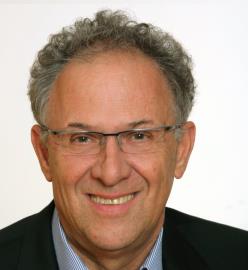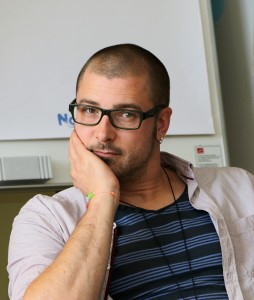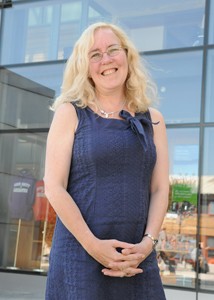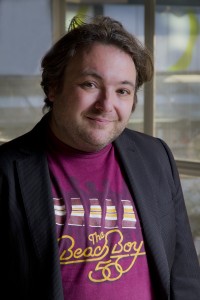Illustrations from keynotes:
Learners’ Digital Competence
Guests:
Mitja Čepič Vogrinčič, PI, Lidija Kralj, OŠ Veliki Bukovec, Hrvaška, Nives Kreuh, ZRSŠ
Neža Barbara Brečko, FDV, UL in Radovan Krajnc, ZRSŠ
Moderators:
Andreja Bačnik in Anita Poberžnik, ZRSŠ
Speakers’ cues
Mitja Čepič Vogrinčič, researcher at the Educational Research Institute
ICILS 2013 – Computer and Information Literacy is a Result of Teacher’s Work
The International Computer and Information Literacy Study (ICILS 2013) is the first international study that measured the computer and information literacy (CIL) of 8th graders in Slovenia and other countries. The study was coordinated by the International Association for the Evaluation of Educational Achievement (IEA).
Through the study we wanted to measure the CIL of the students, defined as the ability of the individual to use computers to investigate, create and communicate in order to participate effectively at home, at school, in the workplace.
219 Slovenian primary schools (3740 8th grade students and 2787 teachers) were involved in the study. The achievement of Slovenian students was slightly above the international average. Out of 14 countries whose result allowed for comparison Slovenia’s 8th graders came out between ranks 7 and 10 with the average score of 511 (the international average was 500).
Other findings of the study seem to be more important than rankings. The study assessed technical, receptive and productive skills of students, but also the evaluation skills and safe and ethical use of computer-based information. It showed that CIL in students is not acquired via some kind of “osmotic” processes and it also challenged the notion of contemporary youth as being digitally native. CIL as other “literacies” is in many ways dependent on the teacher’s work.
Lidija Kralj, OŠ Veliki Bukovec, Croatia
Generations that are currently receiving their education and those yet to come should get prepared for everyday interaction with information and communication technology. European Parliament and the Council of the European Union included digital competence in key competencies which each person needs to possess in order to adapt to the rapidly changing world. Their definition of digital competence, along with knowledge and skills, include critical attitude toward the responsible use of ICT. At the moment, Croatia does not have a national strategy for the internet safety and not even the minimum of children’s knowledge about appropriate and safe use of internet is obligatory in school curriculum. Currently, students in compulsory schools in Croatia have a chance to obtain digital competencies and knowledge only if they choose an elective subject – Informatics in grades 5 to 8, or if similar extra-curriculum activity is enabled for grades 1 to 4. Curriculum for Informatics is ten years old and not aligned with today’s conditions.
OŠ Veliki Bukovec together with partners OŠ Popovača, OŠ “Mladost”, OŠ “Gripe” and OŠ “Mato Lovrak”, finished a 16-month European Union-funded project ” Children’s safety on the Internet ” developing new school curriculum area for children’s safety on the Internet for students aged 7 -14, their parents, teachers and local community. Curriculum consist of pedagogical-didactical model, acceptable use policies, multimedia resources, textbooks and guides. The project aims to improve students’ digital competences and encourage children to assume responsibility for their own safety with a focus on empowerment, emphasizing responsible behaviour and digital citizenship and to raise student teacher, parents and general public awareness and understanding of issues relating to children’s safety online in synergy with the EU policies. All educational resources are available on project web site http://petzanet.hr
Nives Kreuh, ZRSŠ
To be or not to be
When we ask ourselves what student digital competence stands for, we think of digital natives and March Prensky who defined the term already fourteen years ago. However, at that time there was no Facebook, Twitter, You Tube, etc. While we accepted these views and now everyone is talking about them, another set of changes has been taking place and the concept of digital natives is changing in the direction of a different culture rather than technology.
So what is the future of education? Ideas already exist: we can no longer talk about learning, but rather becoming – becoming a good, capable, world-improving person; technology is an extension of our mind in the physical and metaphorical sense (not only in terms of smart clothes), which is a complete novelty for us, yet it is already changing society. The fact is that we need a completely new curriculum, which will no longer be classics, but will consist of subjects such as effective thinking, behaviour, relationships, achievements … with the strong support of technology.
Such education should also be part of the professional development of each individual and especially educators. The international project MENTEP will produce online self-assessment tool for teacher digital competences with the aim to encouraging professional development for teachers, and the areas of self-assessment are based in the direction of the new curriculum. A little fragment …
Neža Barbara Brečko, FDV, UL
Digital competence is one of the eight key competences which should be acquired during the schooling. Under the auspices of the European Commission, the Digital competence framework was developed. The framework is represented as a matrix composed of five areas of digital competence (information, communication, content creation, security, and problem solving) and competencies belonging to those areas.
The proposed framework can serve as a meta framework within which can other frameworks, initiatives, curricula and certifications can be found. Although the framework is very detailed in the listing and describing the competencies needed today for being able to operate in the digital environment it allows the competencies to be administered in various ways, depending on context and use (also in education, curriculum development etc). The question that we pose is, which digital skills should pupils acquire during schooling, in what way they should be acquired and how should these competencies be mesured.
Radovan Krajnc, ZRSŠ
Are digital natives really digitally competent?
It is believed that today’s generation has mastered computer science. That is not true. Computer science is the science that is not included in the compulsory curriculum of primary and secondary school. In schools, there are clubs, extracurricular activities and elective computing subjects attended by a certain percentage of students. The majority of students are not attending these activities. International survey ICILS 2013 noted that only 16% of 8th graders know how to independently solve a problem with the computer. What can schools and teachers do to improve this situation?
It is important that the belief in the introduction replace with a new belief. Students are not born with the knowledge and if something is not learned, then we can reliably assume that these knowledge is not present. We have in mind all students, especially those who do not live in a favorable social and economic environment, who not have educated parents and do not know how to use digital equipment meaningful and useful. Here the school should carry out its role. The school should reduce the differences among students, so it would make sense that schools make a reflection on how coordinatingly develop the digital competences in all subjects across the vertical. There is no one who could do it instead of us. By coordination and planning the main role should take the principal and the so called ROID (organizer of computing activities).
Tomi Dolenc and Janko Harej, Arnes
With the introduction of new e-services, we often get the feeling that these digital novelties are an additional burden, rather than making everyday life easier. Therefore we have approached the development of services for the E-school bag from another angle – we based them on the actual desires of our customers and prepared solutions for those requirements expressed by the users of the entire education vertical of education that are really important. Naturally, we tried to make them more accessible, taking mobile devices into account.
You’ve probably already noticed that access to services on the SIO portal is considerably simpler, but you are probably unaware of the many tools available to simplify things even further. The issue and storage of certificates for your training sessions, for example. Wouldn’t it be so much easier if the information on certificates in the field of ICT education were collected in one place? You can also save all the documents you otherwise store on various cloud services such as Dropbox, Flickr, Google and others to your portfolio very easily. I suppose it goes without saying that the documents stored in your portfolio will remain in Slovenia and that there’s no need to worry about your documents disappearing if the cloud services provider goes out business. Do you already know what a school e-card is, where you can see one, and what they’re actually for? What does your website and online classroom look like today, and what will they look like tomorrow? We have already made improvements to the E-school bag and, through a Single Sign On, also linked the important services that make your work easier – such as online surveys.
The community of SIO and E-school bag users will grow very rapidly in the future and you are, or will be, part of this community, too. It will therefore be very useful to bring yourself up to speed with the services that are available to you and simplify your daily work and professional development as well as solve some of your concerns and offload them to ARNES.
Andreja Čuk, Amela Sambolić Beganović, ZRSŠ
At the closing conference of the E-schoolbag project we will present the most notable achievements of the project. We will sneak a peek into newly developed interactive textbooks, present the results of the pilot project, the evaluation of the project, developed e-services, teacher support, the SIO website, the e-editor, the edustore … We will answer the question if pupils’ schoolbags have become less heavy. All this and more in presentations of 20 slides in 400 seconds.
Decision making – a skill for lifeDecision-making is usually understood as the procedure of choosing a variant or an alternative from several possibilities so that the selection is the one that best fits the goals. In this process, we encounter a wealth of human values, interests, abilities, emotions and passions. It is not surprising that we often make decisions without knowing how. Yet it is people who assess, evaluate and make decisions. This contribution is based on knowledge of decision-making that forms the common denominator for making good decisions. This means knowledge of decision-making problems that typically includes knowledge of the goals, variants, assessment criteria and our preferences. This should be complemented with knowledge of organisational methods and techniques and the execution of the decision-making process. In particular, we are interested in the place and role of contemporary ICT and its added value in decision-making. The saying “Two heads are better than one” means we should make decisions in groups. Group decision-making can also be understood as a learning process. We learn from each other, and collect and use data in order to acquire knowledge for decision-making. Naturally, different interests emerge, which are often contradictory. Therefore, we will particularly focus on decision-making methods and techniques when coordinating different interests. We will find answers to the question of how to participate in a decision-making group and use ICT to make better decisions.
 Vladislav Rajkovič, PhD, is a professor emeritus of information systems and had of Laboratory for Decision Processes and Knowledge-based Systams at the Faculty of Organisational Sciences, University of Maribor, Slovenia. He also works with the Department of Intelligent Systems at the Jožef Stefan Institute in Ljubljana. His research interests focus on information systems and artificial intelligence methods for supporting decision and educational processes. For several years he has been involved in informatisation of Slovenian schools.
Vladislav Rajkovič, PhD, is a professor emeritus of information systems and had of Laboratory for Decision Processes and Knowledge-based Systams at the Faculty of Organisational Sciences, University of Maribor, Slovenia. He also works with the Department of Intelligent Systems at the Jožef Stefan Institute in Ljubljana. His research interests focus on information systems and artificial intelligence methods for supporting decision and educational processes. For several years he has been involved in informatisation of Slovenian schools.
Illustrations from keynotes:
The paper addresses the shift from traditional to modern teachers’ roles within the context of modern approaches to teaching and learning. The paper proposes the framework of discussion (from technocracy to democracy and from centered to disperse distribution of responsibility for learning) and then analyses the shift of teachers’ roles in the following dimensions of the lesson: Lesson content design; Setting up the lesson’s goals and outcomes; Design of assessment; Methods: Teacher’s and students’ responsibility for own outcomes and progress. The paper draws upon an interdisciplinary learning scenario and its feedback from students and teachers to elaborate upon the advantages and setbacks of modern approaches to teaching and learning. Here, the paper discusses the modern possibilities of students leaning form each other, and of teachers learning from students.
 Klemen Sabina is initially trained as a sociology, philosophy and civics high school teacher, with international teaching experience. Currently, Klemen Slabina works at Tallinn University, Centre for Innovation in Education as the Head of Development. He is one of the founders of the Centre. He is a Doctoral student at Tallinn University.
Klemen Sabina is initially trained as a sociology, philosophy and civics high school teacher, with international teaching experience. Currently, Klemen Slabina works at Tallinn University, Centre for Innovation in Education as the Head of Development. He is one of the founders of the Centre. He is a Doctoral student at Tallinn University.
His field of expertise (rooting of new approaches in teaching and learning) is elaborated upon through his outcomes:
– Design and implementation of the new Innovative Learning Environment for Teacher Education at TU
– Education4Future International Academic In-service Program for Educational Leaders: member of consortium between Estonia, The Netherlands, Switzerland, and Liechtenstein; responsible for content and curriculum design, leading, and training.
Illustrations from keynotes:
New social and participatory media give learners and teachers a plethora of ways to interact with rich media and to communicate and collaborate. Mobile devices means learning anywhere, anytime is now a reality. The talk will consider the characteristics of digital technologies and will consider the implications for learning and teaching. It will describe the 7Cs of Learning Design framework that can be used to help teachers make more informed design decisions that are pedagogically effective and make appropriate use of digital technologies It will look at the relationship between Learning Design and Learning Analytics. It will draw on current research in the field and will extrapolate which the future of learning might look like in the near future.
 Gráinne Conole joined the University of Bath Spa on 1st February 2015 as Chair in Education. She was previously at University of Leicester, where she was professor of learning innovation and director of the Institute of Learning Innovation. Her research interests include: the use, integration and evaluation of Information and Communication Technologies and e-learning, research on Open Educational Resources (OER) and Massive Open Online Courses (MOOCs), new approaches to designing for learning, e-pedagogies, social media and the impact of technologies on organisational change. She regularly blogs on www.e4innovation.com and her Twitter ID is @gconole. She has successfully secured funding from the EU, HEFCE, ESRC, JISC and commercial sponsors). She was awarded HEA National Teaching Fellowship in 2012. She is also a fellow of EDEN and ASCILITE. She has published and presented over 1000 conference proceedings, workshops and articles, including the use and evaluation of learning technologies. She has recently published a Springer book entitled ‘Designing for learning in an open world’ and is currently working on a Routledge book on practical Learning Design.
Gráinne Conole joined the University of Bath Spa on 1st February 2015 as Chair in Education. She was previously at University of Leicester, where she was professor of learning innovation and director of the Institute of Learning Innovation. Her research interests include: the use, integration and evaluation of Information and Communication Technologies and e-learning, research on Open Educational Resources (OER) and Massive Open Online Courses (MOOCs), new approaches to designing for learning, e-pedagogies, social media and the impact of technologies on organisational change. She regularly blogs on www.e4innovation.com and her Twitter ID is @gconole. She has successfully secured funding from the EU, HEFCE, ESRC, JISC and commercial sponsors). She was awarded HEA National Teaching Fellowship in 2012. She is also a fellow of EDEN and ASCILITE. She has published and presented over 1000 conference proceedings, workshops and articles, including the use and evaluation of learning technologies. She has recently published a Springer book entitled ‘Designing for learning in an open world’ and is currently working on a Routledge book on practical Learning Design.
Illustrations from keynotes:
There are many common myths about how people learn or how we teach, often they are blocking the implementation of real stuff that works. Some of those myths concern the use of technology in education. So doesn’t technology make education better by definition, but neither is education without modern technology by definition good. In this talk some of the more common myths about learning and education – such as learning styles and digital natives – will be replaced by new – and old, but too little known – insights on learning with or without technology with specific discussing the personalization of learning. Some examples of the insights that will be presented: personalized review, dual channel theory, …
 Pedro De Bruyckere is an educational scientist at Arteveldehogeschool, Ghent Belgium (www.arteveldehs.be) since 2001. He co-wrote several book in which he debunks popular myths on GenY and GenZ, education and popular culture. March 2015 Academic Press will release the book Urban Myths about Learning and Education, a book he co-wrote with Paul Kirschner and Casper Hulshof. Pedro is an often-asked public speaker; one of his strongest points is that he is funny in explaining serious stuff. He is finishing his PhD on the perception of authenticity. In December 2012 Pedro was chosen as most inspiring public speaker on education during ‘De Kunst van het Inspireren’ in Amsterdam.
Pedro De Bruyckere is an educational scientist at Arteveldehogeschool, Ghent Belgium (www.arteveldehs.be) since 2001. He co-wrote several book in which he debunks popular myths on GenY and GenZ, education and popular culture. March 2015 Academic Press will release the book Urban Myths about Learning and Education, a book he co-wrote with Paul Kirschner and Casper Hulshof. Pedro is an often-asked public speaker; one of his strongest points is that he is funny in explaining serious stuff. He is finishing his PhD on the perception of authenticity. In December 2012 Pedro was chosen as most inspiring public speaker on education during ‘De Kunst van het Inspireren’ in Amsterdam.
Illustrations from keynotes:
Dragica B. Banović, mag. Valentina Mavrič Klenovšek, ŠC Novo mesto, Srednja elektro šola in tehniška gimnazija
In the previous school year the Secondary school of electronics and technical gymnasium of the School Centre Novo mesto took part in the project of the National Education Institute of the Republic of Slovenia Introducing and using e-contents and services. We started a path together with fourteen pilot schools (secondary schools as well as gymnasiums) from all parts of Slovenia, which received tablet computers as their primary tools that were used in each school in a pilot class.
At present we have been testing the existing e-student books from the field of science (chemistry and mathematics) as well as other e-materials that are being produced. We are regularly researching the library of different programmes and applets in order to find those that would operate as a motivational means on one hand, but on the other hand they would enable the development of critical thinking among students as well as the achievement of higher taxonomic levels of their knowledge.
The main achievement in the project were not not tablet computers nor e-materials. Looking back on it, on realised learning situations, it shows team work of teachers and collaborative learning of students. The teachers’ team work was reflected in exchanging ideas and experiences. Collaborative learning of students was helpful for everyone when working with modern ICT. Students and teachers worked together without any restraint, which proved to be successful and beneficial for both sides. That is the main achievement on our path to introducing and using e-contents and services- knowing how to work in a team.
Mirijam Pirc, ŠC Nova Gorica
Teachers and students at the School Centre Nova Gorica were involved in the project “e-šolska torba”. The subjects included in the project were Slovenian, Mathematics, Chemistry, Biology and Physics. The teachers gained valuable experience in using e-books and e-services in the classroom. Slovene is one of the subjects of the humanities and keeps pace using modern technology in class. Alongside new didactical approaches, which not only cover lesson organisation, but cooperation between teachers as well, we try to incorporate the digital media into the teaching of Slovene at our high schools. First and foremost, this is suggested in the curriculum accepted in 2008 for high school Slovene, which had already anticipated a change of teaching methods in this regard. The pursuit of modern methods has been encouraged by official institutions as well (ZRSŠ), which have provided the tools we can use during lessons, and a digital workbook. At Mathematics, the quality of e-learning material is very high and e-textbox represents an important contribution to the enrichment of methods and strategies in teaching and learning. The tasks check students’ understanding in many different ways. Consequently, the teacher should consider very carefully which parts of the material to use to achieve specific learning targets and not to make the students “lose” themselves in the e-textbook. E-learning at Chemistry can be used to check the students’ primary school knowledge, to learn new facts and to consolidate the established knowledge. In order to achieve the desired goals, the teacher must choose the strategies and methods very carefully. Students can be “supersaturated” with the abundance of new concepts and e-learning methods. At Science subjects like Biology and Physics teachers use a variety of tools which are available on the World Wide Web: Socrative program, collaborative cards Cram.com, application Exe, Google’s drive and Vernier sensors.